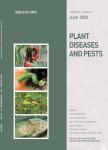Community Structure of Endophytic Bacteria in Chestnut, Castanea mollissima
Community Structure of Endophytic Bacteria in Chestnut,Castanea mollissima作者机构:College of Agriculture Kunming University Kunming 650214 China Yunnan Engineering Research Center for Characteristic Agriculture Kunming 650214 China Kunming Institute of Zoology Chinese Academy of Sciences Kunming 650223 China Department of Life Science and TechnologyKunming University Kunming 650214 China
出 版 物:《Plant Diseases and Pests》 (植物病虫害研究(英文版))
年 卷 期:2016年第7卷第4期
页 面:1-5页
学科分类:0710[理学-生物学] 1007[医学-药学(可授医学、理学学位)] 100705[医学-微生物与生化药学] 07[理学] 09[农学] 071005[理学-微生物学] 0902[农学-园艺学] 090201[农学-果树学] 10[医学]
基 金:Supported by National Natural Science Foundation of China(31460491) Applied Basic Research Project of Science and Technology Department of Yunnan Province(2013FD040) Scientific Research Project of Education Department of Yunnan Province(2014Y390) Talent-Recruiting Program of Kunming University(YJL14005) Key Disciplines (Ecology) Project of Colleges and Universities in Yunnan Province
主 题:High-throughput sequencing Detection Chestnut Endophytic bacteria
摘 要:[ Objective] The paper was to detect the species of endophytic bacteria in Chestnut (Castanea mollissima). [ Method ] The 16S rDNA-V4 region of endophytic bacteria in chestnut (sample name BL) was sequenced by Illumina MiSeq high-throughput sequencing technology. The number of sequences and op- erational taxonomic units (OTUs) for each sample was sorted and calculated using Qiime and Mothur software. The abundance and α-diversity of species were analyzed. [ Result] The number of effective sequences and OTUs were 21 167/191. The rarefaction curves showed that adequate sampling was achieved, and the number of OTUs was close to saturation. The endophytic bacteria of chestnut belonged to 10 genera, including Koribacter (3.48%) , Solibacter (2.59%) , Bra- d^hizobium ( 3. 57% ), Rhodoplanes ( 7. 41% ), Methylobacterium ( 4. 20% ), Agrobacterium ( 19. 73% ), Kaistobacter ( 2. 05% ), Sphingomonas (18.66%), Acidovorax (35.98%), and Methylibium (2.32%). The dominant species were Acidovorax, Agrobacterium and Sphingomonas. [ Conclusion] Illumina high-throughput sequencing technology provided more accurate and scientific data resources for the study of endophytic bacteria in chestnut.



